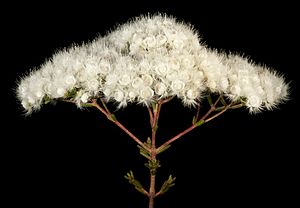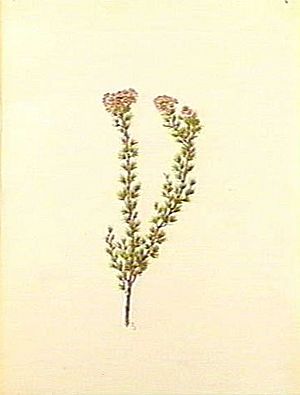Pink brownii facts for kids
Quick facts for kids Pink brownii |
|
|---|---|
 |
|
| Scientific classification | |
| Genus: |
Verticordia
|
| Species: |
brownii
|
Verticordia brownii, often called pink brownii or pink cauliflower, is a lovely flowering plant. It is part of the myrtle family, Myrtaceae. This plant grows only in the south-west area of Western Australia. It has small, neat, oval-shaped leaves. Its flowers are usually pale pink to magenta, but they can also be white.
This plant was one of the first Verticordia plants ever collected. It was found by a botanist named Robert Brown in 1802. He found it during a trip around the Australian mainland on a ship called HMS Investigator.
Contents
What Does Verticordia brownii Look Like?
Verticordia brownii is a shrub that grows upright or in a rounded shape. It can reach a height of about 20 to 70 centimeters (8 to 28 inches). It can spread out to be 10 to 60 centimeters (4 to 24 inches) wide. The plant has one main stem at its base. This stem then splits into many smaller branches that grow upwards, forming a flat top.
The leaves are shaped like an oblong or an egg, with the narrower end at the bottom. They are slightly curved inwards and are about 3 to 4 millimeters (0.12 to 0.16 inches) long. Leaves closer to the flowers are shorter than those further down the stems.
Flowers and Their Features
The flowers of Verticordia brownii often have a pleasant smell. They grow in groups near the ends of the branches. Each flower sits on a straight stalk that is about 2 to 4 millimeters (0.08 to 0.16 inches) long.
- The floral cup is shaped like half a flattened ball. It is about 1 millimeter (0.04 inches) long and has a narrow part in the middle. It feels bumpy and has hairs near its base.
- The sepals are usually pale pink to magenta. They can fade to white, and sometimes they are completely white. They are about 2 millimeters (0.08 inches) long. Each sepal has 3 or 4 feathery parts and one or two hairs that can be up to 4.5 millimeters (0.18 inches) long.
- The petals are the same color as the sepals. They are about 1.2 to 2.0 millimeters (0.05 to 0.08 inches) long and are egg-shaped to almost round.
- The style is straight and about 5.5 to 6 millimeters (0.22 to 0.24 inches) long. It has hairs near its tip.
This plant usually flowers from December to February.
How is it Different from Similar Plants?
Verticordia brownii looks a lot like another plant called Verticordia eriocephala. Both plants have a woolly or "cauliflower" look. However, V. eriocephala has a shorter style (about 3.5 to 4 millimeters or 0.14 to 0.16 inches) that is smooth, without hairs. Also, the flowers of V. eriocephala are always white or creamy-white. The flowers of V. brownii are only sometimes white.
How Verticordia brownii Got Its Name
The first time this plant was collected was in 1802. This happened at Lucky Bay in what is now Cape Le Grand National Park. The collection was made by Robert Brown during the trip around Australia.
In 1819, a scientist named René Louiche Desfontaines officially described the plant. He named it Chamelaucium brownii to honor Robert Brown, who collected the first sample.
Later, in 1828, another scientist named de Candolle described the group of plants called Verticordia. He then renamed this plant Verticordia brownii. This made it one of the first plants to be placed in the Verticordia group, which now has about 100 different species.
Scientists group plants into categories to understand them better. In 1991, a botanist named Alex George studied the Verticordia group. He placed Verticordia brownii into a smaller group called Corymbiformis.
Where Does Verticordia brownii Grow?
You can find this Verticordia plant in Western Australia. It grows between Hopetoun and Mount Ragged in the Cape Arid National Park. It also extends inland almost to Grass Patch.
It likes to grow in deep red or yellow sands, especially on ridges and coastal sand dunes. It can also be found in sandy or clay soils that come from granite. You will often see it in open scrublands and heaths (areas with low-growing shrubs).
Is Verticordia brownii Protected?
The Western Australian Government's Department of Parks and Wildlife says that Verticordia brownii is "not threatened." This means it is not currently in danger of disappearing.
How People Use Verticordia brownii
People started growing this plant not long after it was discovered. Its many beautiful flowers caught the eye of plant growers in England.
Today, Verticordia brownii is grown as an ornamental shrub. This means it is grown for its beauty in gardens. It is a small plant, usually with many rose-pink flowers that smell nice. In gardens, these flowers can appear from November until April. They open all at once, almost covering the leaves and branches.
This plant is usually grown from cuttings, which are small pieces of the plant that can grow into new plants. It grows well in sandy, gravelly, or loamy soils. Sometimes, the woolly, honey-scented flowers can appear in the plant's very first year of growth. The dried flowers are also popular for flower arrangements because they keep their color for a long time.



